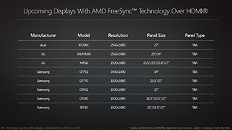- Joined
- Oct 9, 2007
- Messages
- 47,477 (7.50/day)
- Location
- Hyderabad, India
| System Name | RBMK-1000 |
|---|---|
| Processor | AMD Ryzen 7 5700G |
| Motherboard | ASUS ROG Strix B450-E Gaming |
| Cooling | DeepCool Gammax L240 V2 |
| Memory | 2x 8GB G.Skill Sniper X |
| Video Card(s) | Palit GeForce RTX 2080 SUPER GameRock |
| Storage | Western Digital Black NVMe 512GB |
| Display(s) | BenQ 1440p 60 Hz 27-inch |
| Case | Corsair Carbide 100R |
| Audio Device(s) | ASUS SupremeFX S1220A |
| Power Supply | Cooler Master MWE Gold 650W |
| Mouse | ASUS ROG Strix Impact |
| Keyboard | Gamdias Hermes E2 |
| Software | Windows 11 Pro |
AMD is readying a slew of feature-set additions to its Radeon GPUs, in 2016, targeted at display technology. To begin with, AMD is redesigning FreeSync, its adaptive-sync technology, to work over HDMI. The tech currently requires DisplayPort 1.2a. For this to work, the display should support FreeSync over HDMI on its end, as well. It's not as if every current HDMI display gets adaptive sync. AMD posted a partial list of upcoming displays that support FreeSync over HDMI. With this, AMD is pushing for a new generation of notebooks and convertibles that feature FreeSync displays.
Next up, AMD is implementing high dynamic range (HDR) display support on next-generation Radeon GPUs. Current Radeon GPUs already support 10-bit (30-bit color or 1.07 billion colors, compared to 16.7 million colors on 32-bit); on desktop, Direct3D, and OpenGL apps. HDR will make images look more life-like. AMD claims that 1080p HDR content will look better than 4K SDR (standard dynamic range) content. AMD will also work with game developers to get HDR content on upcoming games.





HDR adds data load to existing display interfaces, and so with the next generation Radeon GPUs, AMD is looking to implement DisplayPort 1.3 HBR3, a display interconnect with a raw bandwidth of 32.4 Gb/s, 80% higher than HDMI 2.0, which will enable 5K (5120 x 2880 pixels) at 60 Hz, over a single connector at SDR; 4K (3840 x 2160 pixels) at 120 Hz SDR or 60 Hz HDR, 3K (3440 x 1440 pixels) at 190 Hz with SDR and 144 Hz HDR; WQHD (2560 x 1440 pixels) at 240 Hz SDR and 170 Hz HDR; and FHD (1920 x 1080 pixels) at 240 Hz on both HDR and SDR.


View at TechPowerUp Main Site
Next up, AMD is implementing high dynamic range (HDR) display support on next-generation Radeon GPUs. Current Radeon GPUs already support 10-bit (30-bit color or 1.07 billion colors, compared to 16.7 million colors on 32-bit); on desktop, Direct3D, and OpenGL apps. HDR will make images look more life-like. AMD claims that 1080p HDR content will look better than 4K SDR (standard dynamic range) content. AMD will also work with game developers to get HDR content on upcoming games.





HDR adds data load to existing display interfaces, and so with the next generation Radeon GPUs, AMD is looking to implement DisplayPort 1.3 HBR3, a display interconnect with a raw bandwidth of 32.4 Gb/s, 80% higher than HDMI 2.0, which will enable 5K (5120 x 2880 pixels) at 60 Hz, over a single connector at SDR; 4K (3840 x 2160 pixels) at 120 Hz SDR or 60 Hz HDR, 3K (3440 x 1440 pixels) at 190 Hz with SDR and 144 Hz HDR; WQHD (2560 x 1440 pixels) at 240 Hz SDR and 170 Hz HDR; and FHD (1920 x 1080 pixels) at 240 Hz on both HDR and SDR.


View at TechPowerUp Main Site






